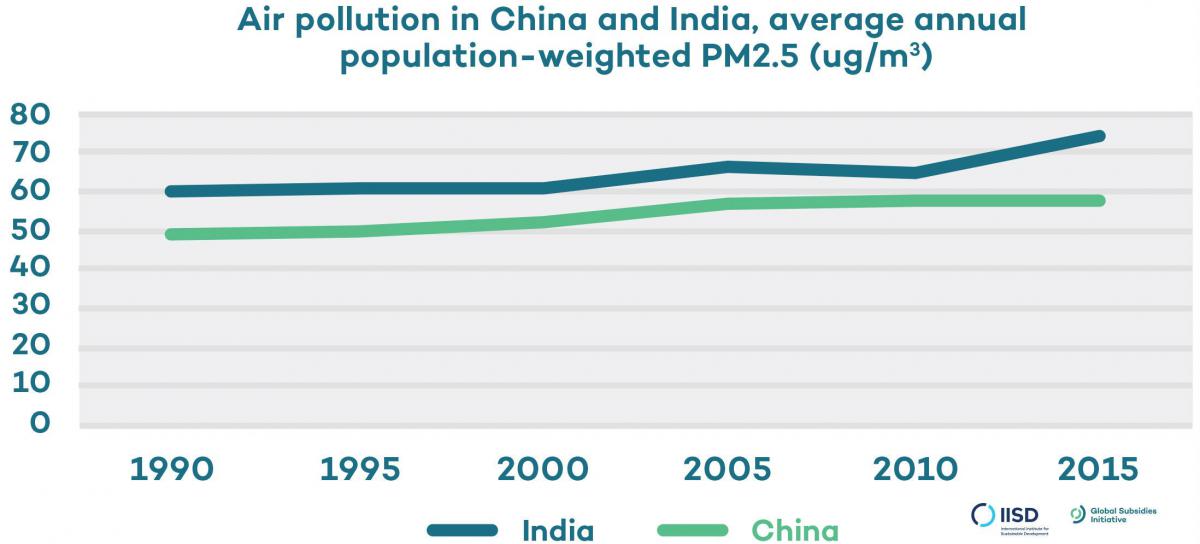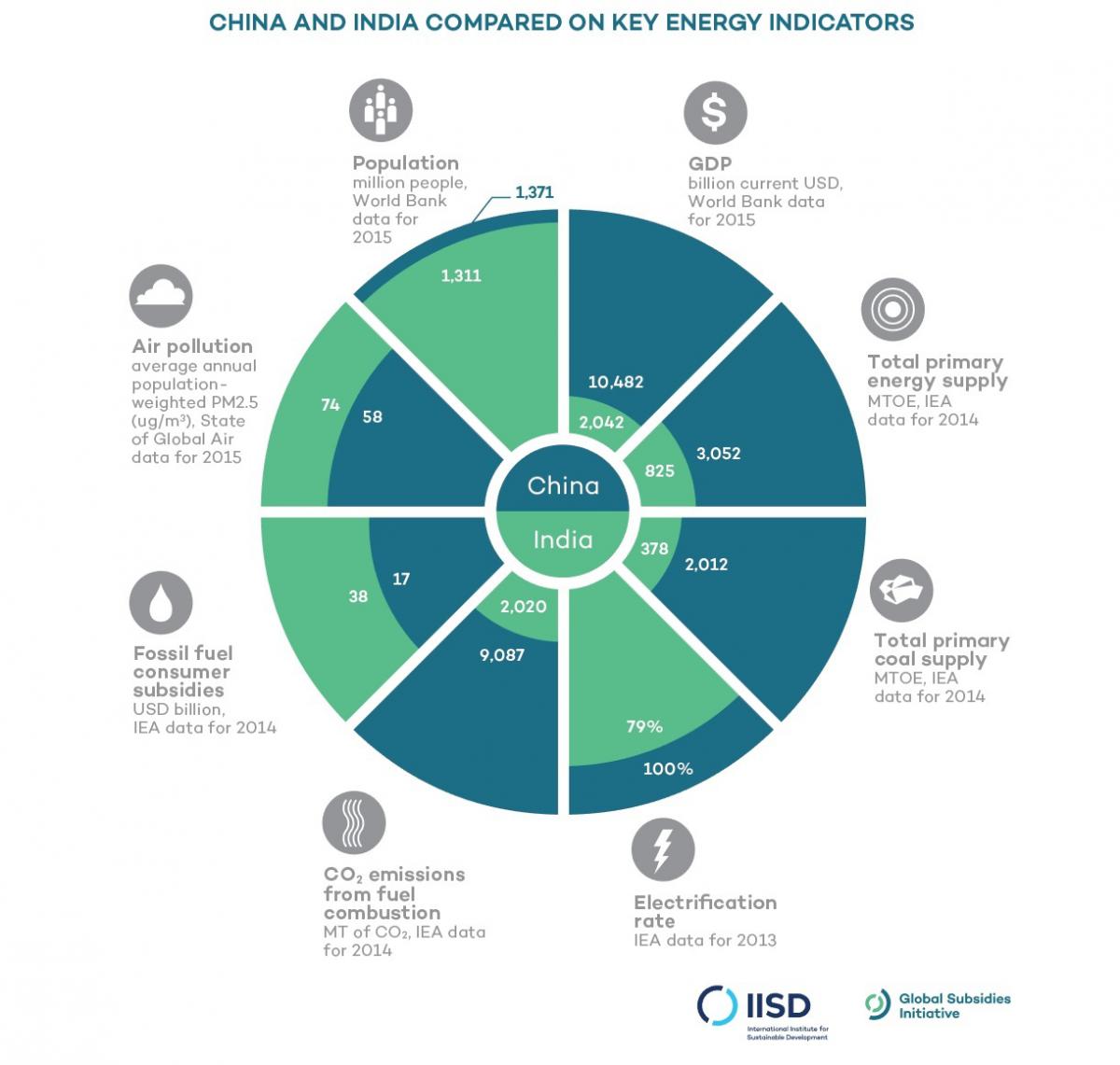Sticks and Toxic Carrots: Clearing the air in China and India
Both countries can do more to ensure that policies on air pollution and clean energy are aligned.
Common problems often require common solutions and the need for a dialogue. This is true in the case of China and India when it comes to tackling air pollution and switching to clean energy.
Poor air quality has become a major political concern in both countries. It was a headline topic at the opening of the National People’s Congress in March, with China’s Prime Minister Li Keqiang reaffirming the government’s commitment to clearing the skies through increased investment in clean energy and implementing tougher sanctions for polluters.

Based on data from www.stateofglobalair.org
In India, independent estimates of the devastating health impacts of emissions from electricity plants, industry and transport cause non-stop public controversies.
In order to effectively tackle the pollution crises, technologies that support clean air, water and soil in both China and India must gradually replace polluting alternatives. Implementation of this transition will largely depend on local factors. So what is the best approach for each government to take in promoting these technologies: the stick or the carrot? And which incentives or disincentives are most effective?
Both countries face similar challenges. Each has prioritized the installation of de-sulfurizing, de-nitrating and de-dusting equipment at existing coal-fired electricity plants to curb harmful emissions. Both China and India have applied emissions standards to their electricity, transport and industrial sectors. However, compliance with these standards remains a major challenge. Beijing, for instance, is still believed to be at least a decade away from blue skies, whereas India lags behind further still.
To complement command-and-control regulations such as emission standards—the "stick”—China is also using a “carrot” by offering a premium sale price to coal-fired generators that have installed emissions abatement equipment. The value of this incentive was estimated at around 100 billion yuan per annum (USD14.5 billion) in 2014 and 2015.
Given its lower level of economic development combined with budgetary constraints, India cannot afford to encourage a reduction of pollution from coal plants in the same way. India prioritizes provision of affordable electricity to its population and improving energy access for the 20 per cent of people that still do not have electricity in their homes. This is very different from China, a country with an electrification rate of 100 per cent that is addressing a major challenge of over-capacity in coal-fired generation.
India also has the cess charge (a form of carbon tax) on coal use that is partially allocated to support clean technologies. Charged at INR400 (USD 6) per tonne of coal, the cess has seen an eightfold increase since 2014. Between 2011 and 2016 an estimated 13,616 crore (over USS 2 billion) from the coal cess revenues was transferred to the National Clean Energy Fund.
Feed-in tariffs and other "carrots" for renewable energy have driven a rapid increase in installed renewable energy capacity in both China and India. However, this additional capacity will only enable a switch to cleaner energy if it is used, and in both China and India some of the new wind capacity has faced curtailment problems.
Among its causes are “toxic carrots” given each government. In China, energy policy is conflicting. While some policies seek to curb coal capacity, others guarantee coal-fired power plants a certain number of hours of operation. Thus, the value of wind curtailment in Liaoning, Jilin, Heilongiang and East Inner Mongolia was estimated at 6.9 billion yuan (USD 1 billion) in 2016 driven partly by the priority given to the use of coal power.
In India, renewable energy developers enjoyed a generous accelerated depreciation allowance but were not given a guarantee for generation or dispatch. However, India has capped this allowance at 40 per cent, and wind power is being developed through a reverse auction mechanism, whereby the bid is won by the seller quoting the lowest price.

These and other examples illustrate that there is a lot of money and also regulations already on the table. What is missing is a system that traces the efficacy of both carrot and stick policies on energy waste and air quality in a way that is simple for governments and other stakeholders to use.
Given increasing budgetary pressures, identifying, quantifying and evaluating policies that assist or interfere with the clean energy transition could help China and India assess the best use of public resources.
One way of doing so would be a voluntary peer review with an expert organization or another country—bilaterally or within such forums as G20 or BRICS. For example, many members of Asia-Pacific Cooperation (APEC) have undertaken voluntary peer reviews on energy efficiency.
Another opportunity is the voluntary review of fossil fuel subsidies within the G20 that China completed jointly with the United States when it was hosting the G20 summit in 2016. The purpose of this review was to identify "toxic carrots"—those measures of government support in the energy sector that result in wasteful consumption of energy. China’s review listed nine subsidies worth USD 14.5 billion and included a timeline for their phase out. India will host the G20 summit in 2019, and, as more G20 countries (Germany, Mexico and Indonesia at the time of writing) volunteer for peer review, there are increasing expectations on India to do the same.
Reposted with permission from chinadialogue. Read IISD's brief on energy subsidy reforms in China and India here.
You might also be interested in
Increased Support Needed to Achieve India's Clean Energy Goals
India is on track to achieve many of its 2030 clean energy goals but needs to step up government support measures to accelerate the deployment of offshore wind, electric vehicles, and green hydrogen, according to a new report.
India Faces Clean Energy Challenges as Energy Demand Soars and Global Fossil Fuel Subsidies Rise
New research finds the global energy crisis and increasing energy demand have pushed India's energy subsidies to a 9-year high.
Heatwaves to hit China once every 5 years as global extreme weather events multiply, study finds
Record-breaking heatwaves that have scorched North America, Europe and China are set to worsen in future unless the world stops burning fossil fuels, according to a study by the World Weather Attribution (WWA) academic initiative.
G20 energy ministers call for cooperation on nuclear energy & low-emission hydrogen
The Group of 20 energy ministers' meeting concluded in Goa on July 22, 2023, with the final summary failing to include language on the phase-down of unabated fossil fuels.
